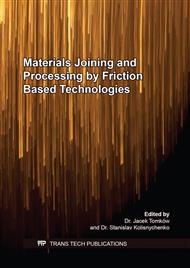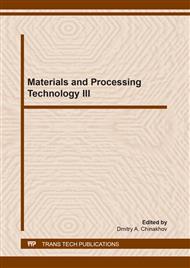[1]
M.St. Węglowski, S. Błacha, A. Phillips, Electron beam welding – Techniques and trends – Review, Vacuum. 130 (2016) 72-92.
DOI: 10.1016/j.vacuum.2016.05.004
Google Scholar
[2]
R. Ilyushenko, V. Nesterenkov, Novel technique for joining of thick section difficult-to-weld aluminium alloys, Mater. Sci. Forum 519-521 (2006) 1125-1130.
DOI: 10.4028/www.scientific.net/msf.519-521.1125
Google Scholar
[3]
S.V. Akhonin, V.Yu. Belous, R.V. Selin, Electron beam welding, heat treatment and hardening of beta-titanium, IOP Conf. Ser. Mater. Sci. Eng. 582 (2019) 012050.
DOI: 10.1088/1757-899x/582/1/012050
Google Scholar
[4]
S. Katayama (Ed.), Handbook of laser welding technologies, Woodhead Publishing Ltd, Cambridge, (2013).
Google Scholar
[5]
C. Mittelstädt, T. Seefeld, P. Woizeschke, F. Vollertsen, Laser welding of hidden T-joints with lateral beam oscillation, Procedia CIRP 74 (2018) 456-460.
DOI: 10.1016/j.procir.2018.08.151
Google Scholar
[6]
A.V. Bernatskyi, O.M. Berdnikova, I.M. Klochkov, V.M. Sydorets, D.A. Chinakhov, Laser welding in different spatial positions of T-joints of austenitic steel, IOP Conf. Ser. Mater. Sci. Eng. 582 (2019) P. 012048.
DOI: 10.1088/1757-899x/582/1/012048
Google Scholar
[7]
L. Markashova, O. Berdnikova, A. Bernatskyi, M. Iurzhenko, V. Sydorets, Physical and mechanical properties of high-strength steel joints produced by laser welding, in: 2017 IEEE International Young Scientists Forum on Applied Physics and Engineering (YSF-2017), IEEE, Lviv, 2017, pp.88-91.
DOI: 10.1109/ysf.2017.8126596
Google Scholar
[8]
L. Markashova, O. Berdnikova, A. Bernatskyi, V. Sydorets, O. Bushma, Crack resistance of 14KhGN2MDAFB high-strength steel joints manufactured by laser welding, IOP Conf. Ser. Earth Environ. Sci. 224 (2019) 012013.
DOI: 10.1088/1755-1315/224/1/012013
Google Scholar
[9]
V. Shelyagin, V. Khaskin, A. Bernatskyi, O. Siora, V.N. Sydorets, D.A. Chinakhov, Multi-pass laser and hybrid laser-arc narrow-gap welding of steel butt joints, Mater. Sci. Forum 927 (2018) 64-71.
DOI: 10.4028/www.scientific.net/msf.927.64
Google Scholar
[10]
O. Berdnikova, V. Pozniakov, A. Bernatskyi, T. Alekseienko, V. Sydorets, Effect of the structure on the mechanical properties and cracking resistance of welded joints of low-alloyed high-strength steels, Procedia Structural Integrity 16 (2019) 89-96.
DOI: 10.1016/j.prostr.2019.07.026
Google Scholar
[11]
I. Krivtsun, U. Reisgen, O. Semenov, A. Zabirov, Modeling of weld pool phenomena in tungsten inert gas, CO2-laser and hybrid (TIG+CO2-laser) welding, J. Laser Appl. 28 (2016) 022406.
DOI: 10.2351/1.4943994
Google Scholar
[12]
V. Sydorets, V. Korzhyk, V. Khaskin, O. Babych, O. Berdnikova, On the thermal and electrical characteristics of the hybrid plasma-MIG welding process. Mater. Sci. Forum 906 (2017) 63-71.
DOI: 10.4028/www.scientific.net/msf.906.63
Google Scholar
[13]
V. Korzhyk, V. Khaskin, O. Voitenko, V. Sydorets, O. Dolianovskaia, Welding technology in additive manufacturing processes of 3D objects, Mater. Sci. Forum 906 (2017) 121-130.
DOI: 10.4028/www.scientific.net/msf.906.121
Google Scholar
[14]
A.I. Ustinov, Y.V. Falchenko, A.Y. Ishchenko, G.K. Kharchenko, T.V. Melnichenko, A.N. Muraveynik, Diffusion welding of γ-TiAl based alloys through nano-layered foil of Ti/Al system, Intermetallics 16 (2008) 1043-1045.
DOI: 10.1016/j.intermet.2008.05.002
Google Scholar
[15]
P. Nachtnebl, L. Kolařík, L. Forejtová, Testing methods for diffusion welding, Mater. Sci. Forum 919 (2018) 404-410.
DOI: 10.4028/www.scientific.net/msf.919.404
Google Scholar
[16]
A.I. Ustinov, I.V. Falchenko, T.V. Melnychenko, L.V. Petrushynets, K.V. Liapina, A.E. Shishkin, Diffusion welding through vacuum-deposited porous interlayers, J. Mater. Process. Technol. 247 (2017) 268-279.
DOI: 10.1016/j.jmatprotec.2017.04.029
Google Scholar
[17]
Y. Wei, H. Li, F. Sun, J. Zou, The interfacial characterization and performance of Cu/Al-conductive heads processed by explosion welding, cold pressure welding, and solid-liquid casting, Metals 9 (2019) 237.
DOI: 10.3390/met9020237
Google Scholar
[18]
G. Costanza, M.E. Tata, D. Cioccari, Explosion welding: process evolution and parameters optimization, Mater. Sci. Forum 941 (2018) 1558-1564.
DOI: 10.4028/www.scientific.net/msf.941.1558
Google Scholar
[19]
J.H. Bevington, Spinning Tubes, U.S. Patent 444,721. (1891).
Google Scholar
[20]
K.K. Khrenov, G.P. Sakhatsky, Method of cold welding of metal parts. SU Patent 97,024 (1953).
Google Scholar
[21]
W.M. Thomas, E.D. Nicholas, J.C. Needham, M.G. Murch, P. Temple-Smith, C.J. Dawes, Friction stir butt welding, Int. Patent PCT/GB92/02203; G.B. Patent 9,125,978.8; U.S. Patent 5,460,317 (1991).
Google Scholar
[22]
M.M. Shtrikman, State and development of the process of friction welding of linear joints (review), Svarochnoe Proizvodstvo 10 (2007) 25-32.
Google Scholar
[23]
R.J. Ding, P.A. Oelgoetz, Auto-adjustable pin tool for friction stir welding, U.S. Patent 5,893,507A (1999).
Google Scholar
[24]
R.S. Mishra, M.W. Mahoney (Eds.), Friction Stir Welding and Processing, ASM Int., Materials Park, (2007).
Google Scholar
[25]
R. Rai, A. De, H.K.D.H. Bhadeshia, T. DebRoy, Review: friction stir welding tools, Sci. Technol. Weld. Joi. 16(4) (2011) 325-342.
DOI: 10.1179/1362171811y.0000000023
Google Scholar
[26]
R.J. Steel, J. Peterson, S. Sanderson, P. Higgins, S.M. Packer, Friction Stir Welding of 20 mm Thickness 1018 Steels, Proc. Twenty-second Int. Offshore and Polar Eng. Conf., Rhodes, Greece, June 17-22, ISOPE, Rhodes, 2012, pp.238-243.
Google Scholar
[27]
G. Buffa, L. Fratini, R. Shivpuri, Finite element studies on friction stir welding process of tailored blanks, Comput. Struct. 86 (2008) 181-189.
DOI: 10.1016/j.compstruc.2007.04.007
Google Scholar
[28]
R. Nandan, G.G. Roy, T.J. Lienert, T. Debroy. Three-dimensional heat and material flow during friction stir welding of mild steel, Acta Materialia 55 (2007) 883-895.
DOI: 10.1016/j.actamat.2006.09.009
Google Scholar
[29]
P.L. Threadgill, A.J. Leonard, H.R. Shercliff, P.J. Withers, Friction stir welding of aluminium alloys, Int. Mater. Rev. 54(2) (2009) 49-93.
DOI: 10.1179/174328009x411136
Google Scholar
[30]
N.T. Kumbhar, K. Bhanumurthy, Friction Stir Welding of Al 6061 Alloy, Asian J. Exp. Sci. 22(2) (2008) 63-74.
Google Scholar
[31]
D. Carron, P. Bastid, Y. Yin, R.G. Faulkner, Modelling of precipitation during friction stir welding of an Al-Mg-Si alloy, Tech. Mech. 30(1-3) (2010) 29-44.
Google Scholar
[32]
A. Bastier, M.H. Maitournam, K. van Dang, F. Roger, Steady state thermomechanical modelling of friction stir welding, Sci. Technol. Weld. Joi. 11 (2006) 278-288.
DOI: 10.1179/174329306x102093
Google Scholar
[33]
A.V. Yakimov, P.T. Slobodyanik, A.V. Usov, Thermophysics of machining, Lybid, Kiev-Odessa, (1991).
Google Scholar
[34]
R. Nandan, T. DebRoy, H.K.D.H. Bhadeshia, Recent advances in friction stir welding – Process, weldment structure and properties, Prog. Mater. Sci. 53 (2008) 980-1023.
DOI: 10.1016/j.pmatsci.2008.05.001
Google Scholar
[35]
A.L. Maistrenko, V.A. Dutka, V.P. Pereyaslav, S.A. Ivanov, Mathematical modeling of the thermal state of technological unit elements during high-rate electric sintering of diamond-containing composite materials, Sverkhtverdye Materialy 4 (1999) 26-35.
Google Scholar
[36]
A.A. Shulzhenko, S.A. Bozhko, A.N. Sokolov, et al., Synthesis, sintering and properties of cubic boron nitride, Naukova dumka, Kiev, (1993).
Google Scholar
[37]
N.B. Vargafnik, Themophysical properties of substances: Reference Book, Tekhnoenergoizdat, Moscow-Leningrad, (1956).
Google Scholar
[38]
V.K. Grigorovich (Ed.) Reference book on steels and their testing methods, Metallurgizdat, Moscow, (1958).
Google Scholar
[39]
V.I. Tumanov, Properties of alloys of tungsten carbide-cobalt system, Metallurgia, Moscow, (1971).
Google Scholar
[40]
Information on http://www.cniga.com.ua/index.files/cuprum.htm.
Google Scholar
[41]
I.K. Kikoin (Ed.), Tables of physical values: Reference book, Atomizdat, Moscow, (1976).
Google Scholar
[42]
V.A. Grigorjev, V.I. Zorin (Eds.), Heat- and mass transfer. Thermal engineering experiment: Reference book, Energoizdat, Moscow, (1982).
Google Scholar
[43]
R.K. Uyyuru, S.V. Kailas, Numerical analysis of friction stir welding process, J. Mater. Eng. Perform. 15(5) (2006) 505-518.
DOI: 10.1361/105994906x136070
Google Scholar
[44]
G. Buffa, L. Fratini, F. Micari, L. Settineri, On the choice of tool material in friction stir welding of titanium alloys, Proc. NAMRI/SME 40 (2012) 1-10.
Google Scholar
[45]
N.V. Novikov, A.A. Shulzhenko, N.P. Bezhenar, et al., Kiborit: manufacture, structure, properties, application, Sverkhtverdye Materialy 2 (2001) 40-51.
Google Scholar



